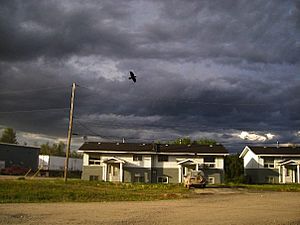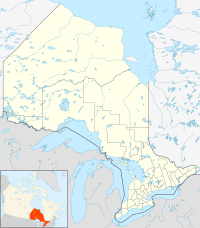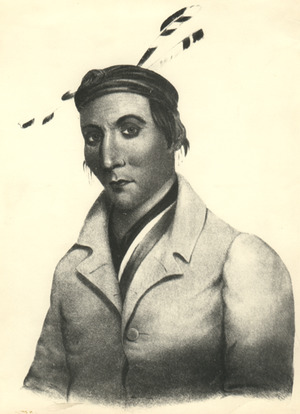Sandy Lake First Nation facts for kids
Quick facts for kids
Sandy Lake 88
ᓀᑲᣞ ᓵᑲᐦᐃᑲᓃᐣᐠ
Negaw-zaaga'iganiing Nitam-Anishinaabe |
|
|---|---|
| Sandy Lake Indian Reserve No. 88 | |
 |
|
| Country | Canada |
| Province | Ontario |
| District | Kenora |
| First Nation | Sandy Lake |
| Area | |
| • Land | 45.69 km2 (17.64 sq mi) |
| Population
(2011)
|
|
| • Total | 1,861 |
| • Density | 40.7/km2 (105/sq mi) |
| Website | www.sandylake. firstnation.ca |
Sandy Lake First Nation is a community of the Oji-Cree people. It is also known by its Oji-Cree name, Negaw-zaaga'iganiing Nitam-Anishinaabe. This First Nations community is located in the western part of Northern Ontario, Canada.
It is found in the Kenora District, about 227 kilometers northeast of Red Lake. In December 2015, the community had a total registered population of 3,034 people. Sandy Lake First Nation is part of the Nishnawbe Aski Nation. They are also a signatory to Treaty 5, which is an agreement between the First Nations and the Canadian government.
The Nishnawbe-Aski Police Service helps keep the community safe. This police service is based on Aboriginal traditions.
Contents
About the Sandy Lake Reserve
The land for Sandy Lake First Nation is called the Sandy Lake 88 Reserve. It covers about 4,266 hectares. In the Oji-Cree language, this land is known as Negaw-zaaga'iganiing.
The main community of Sandy Lake is located within this reserve. In the mid-1900s, the community was known as Waabitigweyaang. This name means "White River."
Community Areas
The Sandy Lake First Nation community has seven neighborhoods. These are grouped into five main districts:
- Airport / Centre
- Big Rock / Ghost Point
- Old Sawmill
- River
- Roman Catholic
Local Services
A store called Northern Store serves the community. It is owned by The North West Company. Sandy Lake is a "fly-in" community. This means that people usually travel there by plane. Wasaya, Superior, and Perimeter Airlines offer flights to the community.
During the winter, there is a special ice road. This road connects Sandy Lake to the rest of the province. It goes southwest towards Deer Lake and Pikangikum. It then connects to Red Lake using the Nungesser Road. This ice road is usually open for about six weeks in the winter.
Education in Sandy Lake
The Sandy Lake Board of Education manages the schools in the community. There are three schools:
- Thomas Fiddler Memorial Elementary School
- Thomas Fiddler Memorial High School
- Washtennigun Christian School
There is also an Adult Learning Center. This center works with Confederation College and Lakehead University. It helps adults continue their education.
Traditional Clans
The people of Sandy Lake First Nation follow a traditional clan system. These clans are called doodem. There are five main clans found in Sandy Lake First Nation:
- Suckers
- Pelicans
- Crane
- Caribou
- Sturgeon
Language and Writing
The people of Sandy Lake First Nation speak the Oji-Cree language. They use a special writing system for their language. It is a type of western Ojibwe Syllabics.
Climate and Weather
Sandy Lake has a subarctic climate. This means it has very cold winters. The summers are usually mild.
Transportation Routes
The Sandy Lake Airport is the main way to travel to and from the community by air.
As mentioned, during the winter months, an ice or winter road is available. This road allows people to drive in and out of Sandy Lake. It starts at the end of Nungesser Road. It goes through North Spirit Lake First Nation. Then, the road splits into two paths. One path goes to Deer Lake First Nation, and the other leads to Sandy Lake First Nation.
Well-Known People from Sandy Lake



